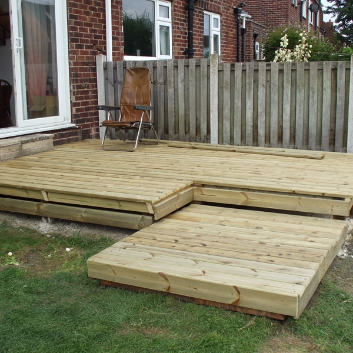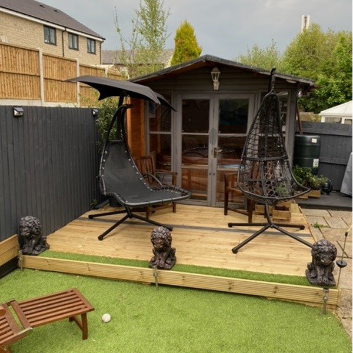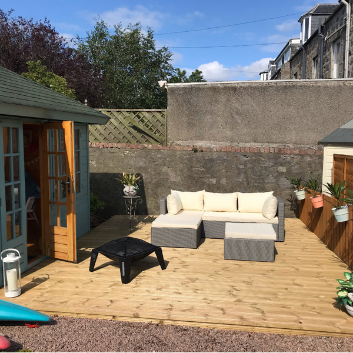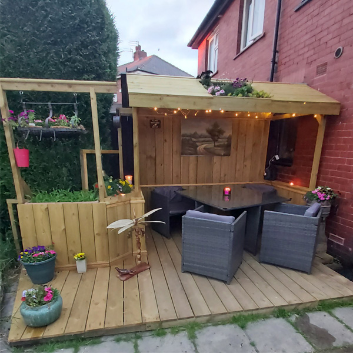Check local branch stock
-
![DKG00000045-01.jpg.jpeg DKG00000045-01.jpg.jpeg]()
![DKG00000045-07.jpg.jpeg DKG00000045-07.jpg.jpeg]()
Timber Decking UC3u Treated Reversible Smooth or Grooved 32 x 125 x 5100mm
Timber Decking UC3u Treated Reversible Smooth or Grooved is high quality decking with the option of having it smooth side up or grooved side up for extra grip. Treated Decking provides an excellent alternative to a paved patio area, offering an... -
![DKG00000045-01.jpg.jpeg DKG00000045-01.jpg.jpeg]()
![DKG00000045-07.jpg.jpeg DKG00000045-07.jpg.jpeg]()
Timber Decking UC3u Treated Reversible Smooth or Grooved 32 x 125 x 5400mm
Timber Decking UC3u Treated Reversible Smooth or Grooved is high quality decking with the option of having it smooth side up or grooved side up for extra grip. Treated Decking provides an excellent alternative to a paved patio area, offering an...
Treated Timber Decking
What to Consider When Buying Decking Boards
When choosing your wood decking boards, keep these points in mind:
- Board size – Match the length of your boards to your deck layout. This helps reduce waste and joints.
- Timber type – Think about style, durability, and whether the wood is treated for outdoor use.
- Surface finish – Grooved boards improve grip and water drainage. Smooth boards give a sleek, modern look.
- Maintenance – Timber decking may need staining or oiling to stay looking its best.
Not sure how many boards you need? Use our Decking Board Calculator and our friendly teams will be happy to help.
to plan your project and order with confidence.Whether you're a trade professional or a DIYer, our team can help you choose the perfect solution. Many of our branches offer a timber cutting service, so you get the exact sizes you need.
Using a CAMO Marksman Edge allows you to insert hidden deck fasteners into the edge of the board, creating a neat finish without gaps. This tool works with any size of decking.
For exceptionally wide boards, the CAMO Wide Board Marksman Pro is a better choice because it includes a spacer for guidance.
Where to Use Timber Decking Boards
Decking boards are perfect for covering damaged concrete. They make outdoor areas look clean and inviting.
If your garden is boggy or damp, decking helps lift the space above wet ground, making it usable all year. It also works for sloped or uneven gardens, creating a level area for tables and chairs.
Grooved boards are ideal near pools or water features because the grooves help water run off quickly. For longer decking lengths, choose smooth boards instead for better performance.
At Howarth Timber & Building Supplies, we stock a wide range of decking boards, plus C16 and C24 timbers for your framework. We also offer composite decking and everything you need in our Garden & Landscaping range to complete your outdoor project.
Frequently Asked Questions
How to guides
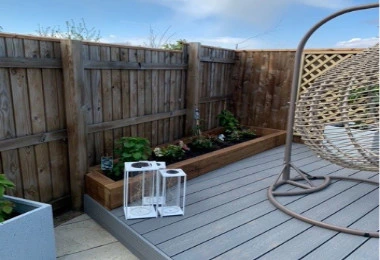
Garden decking ideas
Looking for inspiration? Discover how to build a deck that perfectly suits you with so many options to suit outdoor spaces of any size and shape.
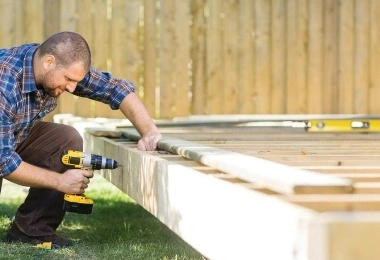
How to build a deck
A step by step guide on how to build a deck.
Customer inspiration
